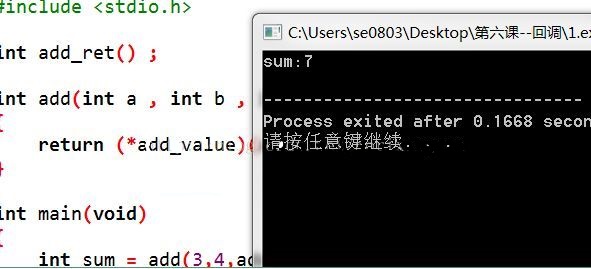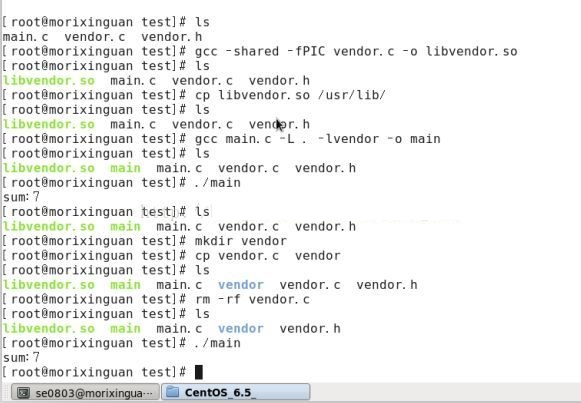| 编辑推荐: |
| 本文来自于tencent,本文主要介绍了C语言回调函数和回调函数在Linux内核中的应用以及在Posix应用API中的使用,希望对您的学习有所帮助。 |
|
一、C语言回调函数
什么是回调函数?
百度的权威解释如下:
回调函数就是一个通过函数指针调用的函数。如果你把函数的指针(地址)作为参数传递给另一个函数,当这个指针被用来调用其所指向的函数时,我们就说这是回调函数。回调函数不是由该函数的实现方直接调用,而是在特定的事件或条件发生时由另外的一方调用的,用于对该事件或条件进行响应。
include <stdio.h>
void print();
int main(void)
{
void (*fuc)();
fuc = print ;
fuc();
}
void print()
{
printf("hello world!\n");
} |
运行结果:

从这个例子可以看到,我们首先定义了一个函数指针fuc ,这个函数指针的返回值为void型,然后我们给函数指针赋值,赋值为print,也就是print函数的首地址,此时fuc获得了print的地址,fuc的地址等于print的地址,所以最终调用fuc();也就相当于调用了print();那么我写的这个例子明显和百度解释的不符合啊?定义是如果你把函数的指针(地址)作为参数传递给另一个函数,当这个指针被用来调用其所指向的函数时,我们就说这是回调函数,确实,有所不同,但道理是一样的,我们接下来再来看一个例子。
#include <stdio.h>
int add_ret() ;
int add(int a , int b , int (*add_value)())
{
return (*add_value)(a,b);
}
int main(void)
{
int sum = add(3,4,add_ret);
printf("sum:%d\n",sum);
return 0 ;
}
int add_ret(int a , int b)
{
return a+b ;
} |
运行结果:

从这个例子里,我们看到:
这样子不就符合我们的定义了嘛?我们把函数的指针(地址),这里也就是add_ret,作为参数int add(int
a , int b , int (add_value)()) , 这里的参数就是int(add_value)()
, 这个名字可以随便取,但是要符合C语言的命名规范。当这个指针被用来调用其所指向的函数时,我们就说这是回调函数。
我们看到add函数内部,return (add_value)(a,b) ; 这个(add_value)(a,b)相当于对指针进行了简引用,我们在main函数中,传入具体要实现功能的函数,add_ret,这个函数很简单,就是实现两数相加并返回,这里刚刚好,简引用,相当于取出指针返回地址里的值,这个值就是return
a+b,也就是我们传入a和b两数相加的结果。
那么,回调函数究竟有什么作用呢?
说到这里,就有了用户和开发者之间的概念,假设,用户是实现add_ret这个函数,而开发者是实现add这个函数,现在的需求是,用户将add_ret这个函数以参数的形式传入开发者实现的add函数,add函数就会返回一个数字给用户,开发者没必要告诉用户他实现了什么东西,用户也并不知道开发者是怎么实现的,用户只需要传入自己写的函数,便可以得到开发者实现的函数的返回值,开发者可以将内容封装起来,将头文件以及库文件提供给用户。
接下来,我们用Linux来演示下这个结果,我们在目录下创建三个文件main.c,vendor.c,vendor.h
main.c是用户开发的。
vendor.c和vendor.h是开发者实现的。
在main.c中,代码如下:
#include <stdio.h>
#include "vendor.h"
int add_ret(int a , int b)
{
return a + b ;
}
int main(void)
{
int sum = add(3,4,add_ret);
printf("sum:%d\n",sum);
return 0 ;
} |
vendor.c,代码如下:
#include "vendor.h"
int add(int a , int b , int (*add_value)())
{
return (*add_value)(a,b);
} |
vendor.h,代码如下:
#ifndef __VENDOR_H
#define __VENDOR_H
int add(int a , int b , int (*add_value)());
#endif |
接下来,我们制作一个动态链接库,最终开发者把vendor.c的内容封起来,把vendor.h提供给用户使用。
#include <stdio.h>
#include "vendor.h"
int add_ret(int a , int b)
{
return a + b ;
}
int main(void)
{
int sum = add(3,4,add_ret);
printf("sum:%d\n",sum);
return 0 ;
} |
在linux下制作动态链接库,将vendor.c和vendor.h打包成一个动态链接库
先明白以下几个命令是什么意思:
生成动态库:
gcc -shared -fPIC dvendor.c -o libvendor.so
参数含义:
-shared : 生成动态库;
-fPIC : 生成与位置无关代码;
-o :指定生成的目标文件;
使用动态库:
gcc main.c -L . –lvendor -o main
-L : 指定库的路径(编译时); 不指定就使用默认路径(/usr/lib/lib)
-lvendor : 指定需要动态链接的库是谁;
代码运行时需要加载动态库:
./main 加载动态库 (默认加载路径:/usr/lib /lib ./ …)
./main
我们将编译动态库生成的libvendor.so拷贝到/usr/lib后,现在就不需要vendor.c了,此时我们将vendor.c移除,也可以正常的编译并且执行main函数的结果,这就是回调函数的作用之一。
操作流程如下:

二、回调函数在Linux内核中的应用
回调函数在Linux内核里得到了广泛的应用,接下来,我将引用Linux内核中文件操作结构体来详细的说明。
我们首先来看到这个结构体,这段代码位于linux内核的include/linux/fs.h中,由于代码众多,我只截取几个最基本的例子:
File_operations文件操作结构体:
struct file_operations
{
struct module *owner;
loff_t (*llseek) (struct file *, loff_t, int);
ssize_t (*read) (struct file *, char __user *,
size_t, loff_t *);
ssize_t (*write) (struct file *, const char __user
*, size_t, loff_t *);
ssize_t (*aio_read) (struct kiocb *, const struct
iovec *, unsigned long, loff_t);
ssize_t (*aio_write) (struct kiocb *, const struct
iovec *, unsigned long, loff_t);
int (*readdir) (struct file *, void *, filldir_t);
unsigned int (*poll) (struct file *, struct poll_table_struct
*);
long (*unlocked_ioctl) (struct file *, unsigned
int, unsigned long);
long (*compat_ioctl) (struct file *, unsigned
int, unsigned long);
int (*mmap) (struct file *, struct vm_area_struct
*);
int (*open) (struct inode *, struct file *);
int (*flush) (struct file *, fl_owner_t id);
int (*release) (struct inode *, struct file *);
int (*fsync) (struct file *, loff_t, loff_t, int
datasync);
int (*aio_fsync) (struct kiocb *, int datasync);
int (*fasync) (int, struct file *, int);
int (*lock) (struct file *, int, struct file_lock
*);
ssize_t (*sendpage) (struct file *, struct page
*, int, size_t, loff_t *, int);
unsigned long (*get_unmapped_area)(struct file
*, unsigned long, unsigned long, unsigned long,
unsigned long);
int (*check_flags)(int);
int (*flock) (struct file *, int, struct file_lock
*);
ssize_t (*splice_write)(struct pipe_inode_info
*, struct file *, loff_t *, size_t, unsigned int);
ssize_t (*splice_read)(struct file *, loff_t *,
struct pipe_inode_info *, size_t, unsigned int);
int (*setlease)(struct file *, long, struct file_lock
**);
long (*fallocate)(struct file *file, int mode,
loff_t offset,
loff_t len);
}; |
这段代码中,利用结构体的封装思想,将函数指针封装在一个file_operations结构体里,然后,在具体实现驱动的时候,实现具体的函数,再赋值给结构体里的函数指针做好初始化操作,我们来看看友善之臂的led驱动就明白了。
static struct
file_operations tiny4412_led_dev_fops = {
.owner = THIS_MODULE,
.unlocked_ioctl = tiny4412_leds_ioctl,
};
static struct miscdevice tiny4412_led_dev = {
.minor = MISC_DYNAMIC_MINOR,
.name = DEVICE_NAME,
.fops = &tiny4412_led_dev_fops,
}; |
首先,先是定义了一个结构体变量,并对结构体变量进行初始化,在这个驱动中,只实现了ioctl函数,对照着上面的结构体,ulocked_ioctl就是结构体中的这个函数指针。
long (*unlocked_ioctl) (struct file *,unsigned int,
unsigned long);
再来看看友善实现的adc驱动里,也是这么来做,这里看到 : 也是C语言结构体的一种初始化方式,也是合理的。
static struct
file_operations adc_dev_fops = {
owner: THIS_MODULE,
open: exynos_adc_open,
read: exynos_adc_read,
unlocked_ioctl: exynos_adc_ioctl,
release: exynos_adc_release,
};
static struct miscdevice misc = {
.minor = MISC_DYNAMIC_MINOR,
.name = "adc",
.fops = &adc_dev_fops,
}; |
在内核中,有很多这样的函数指针,所以,当我们了解了这样的套路以后,再去学习linux内核,我们的思想就会清晰很多了。
再来看看回调函数在linux内核里的基本应用。
从上节我们了解到,回调函数的本质其实也就是函数指针,只不过定义有所区别。它的定义就是:你把函数的指针(地址)作为参数传递给另一个函数,当这个指针被用来调用其所指向的函数时,我们就说这是回调函数。
接下来我们来看一个例子:
这段代码摘自友善之臂的button驱动:
static int tiny4412_buttons_open(struct
inode *inode, struct file *file)
{
int irq;
int i;
int err = 0;
for (i = 0; i < ARRAY_SIZE(buttons); i++) {
if (!buttons[i].gpio)
continue;
setup_timer(&buttons[i].timer, tiny4412_buttons_timer,
(unsigned long)&buttons[i]);
irq = gpio_to_irq(buttons[i].gpio);
err = request_irq(irq, button_interrupt, IRQ_TYPE_EDGE_BOTH,
buttons[i].name, (void *)&buttons[i]);
if (err)
break;
}
if (err) {
i--;
for (; i >= 0; i--) {
if (!buttons[i].gpio)
continue;
irq = gpio_to_irq(buttons[i].gpio);
disable_irq(irq);
free_irq(irq, (void *)&buttons[i]);
del_timer_sync(&buttons[i].timer);
}
return -EBUSY;
}
ev_press = 1;
return 0;
} |
我们在tiny4412_buttons_open函数里看到
err = request_irq(irq,
button_interrupt, IRQ_TYPE_EDGE_BOTH,
buttons[i].name,(void *)&buttons[i]); |
我们来看看request_irq这个函数:
static inline
int __must_check
request_irq(unsigned int irq, irq_handler_t handler,
unsigned long flags,
const char *name, void *dev)
{
return request_threaded_irq(irq, handler, NULL,
flags, name, dev);
} |
到这里我们就明白了,第二个参数是一个用typedef重新定义的一个新类型的函数指针。
那么也就是说一旦执行了tiny4412的open函数,就会通过request_irq去通过回调函数去执行按键中断,并返回一个中断句柄。这个回调函数,其实就是一个中断服务函数。
static irqreturn_t
button_interrupt(int irq, void *dev_id)
{
struct button_desc *bdata = (struct button_desc
*)dev_id;
mod_timer(&bdata->timer, jiffies + msecs_to_jiffies(40));
return IRQ_HANDLED;
} |
回调函数在内核中就是这么来使用的,当然,还有其它的,比如我们在tiny4412的open函数里面还看到:
setup_timer(&buttons[i].timer,tiny4412_buttons_timer,
(unsignedlong)&buttons[i]); |
这个函数的作用是注册一个定时器,通过回调函数tiny4412_buttons_timer来进行触发。
如果你不看它的定义,你可能以为它是一个普通函数,其实它是一个宏封装的。
#define setup_timer(timer,
fn, data) \
do { \
static struct lock_class_key __key; \
setup_timer_key((timer), #timer, &__key, (fn),
(data));\
} while (0) |
这个宏函数通过调用setup_timer_key这个函数来实现定时器的注册:
static inline
void setup_timer_key(struct timer_list * timer,
const char *name,
struct lock_class_key *key,
void (*function)(unsigned long),
unsigned long data)
{
timer->function = function;
timer->data = data;
init_timer_key(timer, name, key);
} |
通过这个例子,我们更加了解到回调函数在Linux内核中的应用,为学习Linux内核,分析linux内核源代码打下了基础。
三、回调函数在Posix应用API中的使用
其实,在Posix应用编程里,我们也能用到回调函数,我们来看看多线程编程中,经常使用的pthread_create函数:
我们先来看看它的原型:
| int pthread_create((pthread_t
*thread, pthread_attr_t *attr, void *(*start_routine)(void
*), void *arg) |
参数说明:
(1) thread:表示线程的标识符
(2) attr:表示线程的属性设置
(3) start_routine:表示线程函数的起始地址
(4) arg:表示传递给线程函数的参数
函数的返回值为:
(1) success:返回0
(2) fair:返回-1
看到这个函数的第三个参数,这不就是一个函数指针,同时也是一个回调函数嘛!这就是函数指针和回调函数在UNIX环境多线程编程中的应用。
我们在windows的dev C++上写一个测试程序来看看:
#include <stdio.h>
#include <pthread.h>
void *function(void *args)
{
while(1)
{
printf("hello world1!\n");
sleep(1);
}
}
int main(void)
{
pthread_t tid ;
tid = pthread_create(&tid , NULL , function
, NULL);
while(1)
{
printf("hello world!\n");
sleep(1);
}
return 0 ;
} |
运行结果:

我们会看到在main函数里的打印语句和在线程回调函数void *function(void *args)里打印语句在同时打印。
当然,应用里还有其它的API通用运用到了回调函数,期待大家在实践中去发掘。 |

